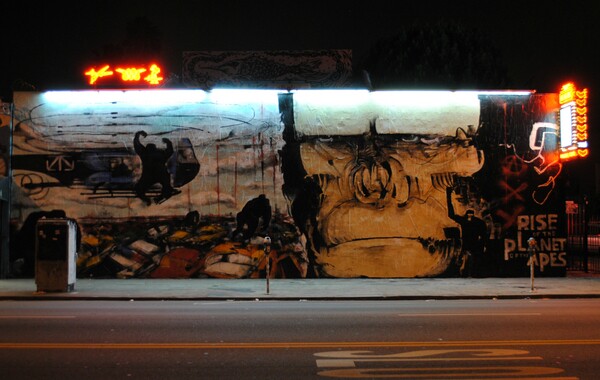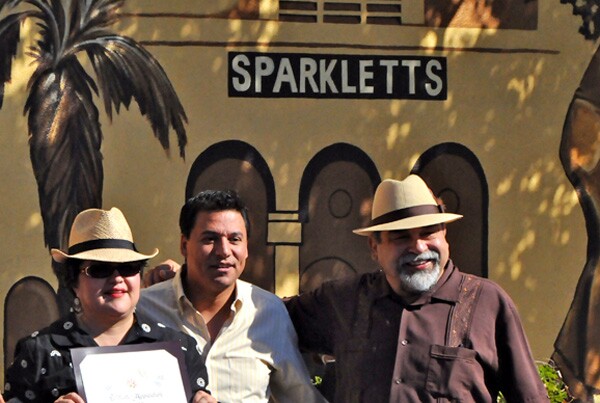New Ordinance Must Distinguish Between Commercial Sign and Fine Art Mural

The civic and artistic evaluation of Los Angeles muralism has opened up passionate talks between artists that carry a range of career experience, from those who began during the social activism of the 1960s to the members of the current self-branding school of street art. All have made a solid case on why their style represents the city's mural legacy. It's a heated debate that will, and should, continue long after a new ordinance is passed.
Yet there is something mural stakeholders have openly agreed on - there should be an easily decipherable definition of a commercial sign versus a fine art mural.
Those murky areas of art-versus-advertising is one of many reasons the Social Public Art and Resource Center (SPARC) began advocating for the Visual Artists Rights Act of 1990 (VARA) and the California Art Preservation Act of 1979 (CAPA) to be included in the city's mural ordinance. The inclusion of those two acts in the ordinance would allow copyright legislation guidelines to define a permitted mural as "work of visual art," protecting them from being removed without notice, and allow artists to retain authorship of the work, according to research led by SPARC.
A commercial logo is defined as an element owned by another party, according to SPARC's recommendation. "You can't copyright a trademark," says Judy Baca, a co-founder of SPARC. VARA does not cover advertisements or works made for hire by an employee "within the scope of his or her employment," as recanted in a 2004 revisit of VARA by George Washington University Law School.
As the draft moves forward, it's the relationship between street art and media companies that can potentially confound the ordinance. They both share a culture of repeated visual iconography to brand a product or person.

Several months ago there was street buzz for Anthony Lister's mural that, according to the artist and studio PR, "honored" the "Rise of the Planet of the Apes." Missing in the hyped responses from sci-fi fans and street art blogs was how an established street artist clearly made commercial signage, coinciding with the film's Blu-ray and DVD release - even if the movie's title logo was removed from the final piece.
"There are many adventure painters here in L.A. right now, like these apes, struggling to live the way they want to live," said Lister in an interview, almost responding to the city's mural ban. Granted, a visiting artist from outside Los Angeles may not know its embattled history between art and commerce - how a mural moratorium was the outcome of litigation between the city and billboard companies.

During the restoration of "History of Highland Park," a 1978 mural on Avenue 56 near Meridian Street, a commercial logo was altered by Baca - one of the original artists who worked on the piece. A Coca-Cola logo, seen in the background on a small neighborhood grocery store sign, was altered to read "Enjoy Murals." The name of the store was also changed, as was a prominent "Sparkletts," which was changed to read "SPARC." The changes were considered preventative measures that would separate a historic mural from being interpreted as a sign.
But it was soon mandated by the city that the original details return to the mural, which according to Baca, reeks of lobbying interests by billboard companies.
But it may have been otherwise. "Community members pointed out changes to the original mural and asked that they be put back to their original state," assured District 14 spokesperson Rick Coca. "Eventually they were."
The mural predates both 1990's VARA and 1979's CAPA.

On the side of a small distribution warehouse on East 16th Street at South Central Avenue in Downtown L.A. a mural was installed by Coca-Cola, whose main bottling plant is located a few blocks north. The undisclosed business owner was approached by the company to install the mural, which is affixed and not painted. There was no cost to him, nor is the warehouse operator being paid for the wall space. "I can have it taken down anytime. Even if I just get tired if it," he said.
Previously, the same wall had a hand-painted mural by a local artist that also featured the iconic Coke bottle - a slightly more sophisticated version of folk art-like pictograms that depict products sold inside a neighborhood store. The current piece is less subtle. While it has elements reflecting the surrounding urban landscape, there is a strong visual reference to a broader ad campaign by Coca-Cola. This wrap has the business owner vulnerable to being fined.
Ed Fuentes has extensively covered mural policy in Los Angeles for KCET's Departures. Read previous mural posts here.
Top photo: History of Highland Park mural with Coca-Cola logo. Photo by KCET Departures.


